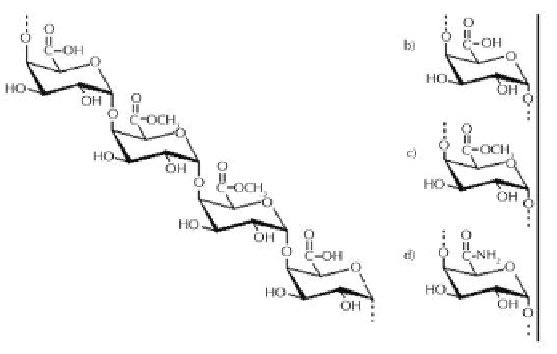Biomedical Engineering Reference
In-Depth Information
(Whitaker, 1970). The most abundant component of the pectic polysaccharides is
polyuronic acids. In the case of higher plants, these polymers are built up mainly
by α-D-galacturonic acid residues. However, in the marine brown algae, the poly-
uronic acids are structurally different and are usually called alginic acids. Some pectic
polysaccharide domains, such as homogalacturonate have a relatively simple primary
structure. This polysaccharide are also called polygalacturonic acid, a (1→4) linked
polymer of α-D-galacturonic acid residues. Another abundant pectic polysaccharide is
rhamnogalacturonan (RG II), which has a long backbone of alternating rhamnose and
galacturonic acid residues. This molecule is very large and is believed to carry long
side-chains of arabinans and galactans. Much further up on the scale of molecular
complexity is highly branched pectic polysaccharides, rhamnogalacturonan (RG II),
which contains a homogalacturonan of at least ten different sugars in a complicated
pattern of linkages (Carpita and McCann, 2001). The rhamnogalacturonans are nega-
tively charged at pH ≥ 5. The side chains of arabinans, galactans, arabinogalactans,
xylose or fucose are connected to the main chain through their C
1
and C
2
atom (vander
Vlugt-Bergmans et al., 2000; Sathyanarayana and Panda 2003). Albersheim (1976)
reported that there are three different polyuronic acids in the primary wall of suspen-
sion cultured sycamore cells. The two of which do confirm are a homogalacturonan
composed of at least 25 D-galacturonic acid residues linked α (1-4) glycosidic link-
ages and a high molecular weight rhamnogalacturonan. It consists of segments com-
posed of about 8 α- 1,4 linked D-galacturonic residues separated from one another
by a trisaccharide nade up of L-rhamnopyranose (1→4), D-galacturonic (α,1→2), L-
rhamnose. The terminal D-galacturonic residues of the pure galacturonan segments
in linked to the L-rhamnose containing trisaccharide by an α,1→2 linkages cause the
chain to zigzag. The polyuronic acids which does not conform to the usual pattern is
also closed as a rhamnogalacturonan but appears to be a much branched structure con-
taining in addition to D-galacturonic acid and L-rhamnose, a variety of other monosac-
charides, some of which are quite rare.
Figure 1.
(a) A repeating segment of pectin molecule and functional groups; (b) carboxyl; (c) ester;
and (d) amide in pectin chain (Sriamornsak, 2001).



Search WWH ::

Custom Search